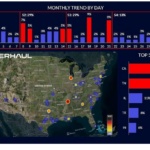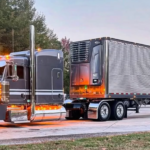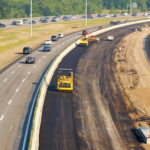As much as truckers focus on the road ahead, plenty of damage is caused when trucks collide with things that sit behind their trailers. Tom Boehler, the Erb Group’s senior director of safety and compliance, offers several tips that can help eliminate backing accidents.
1. Get out and look
The process begins with a central GOAL, which Boehler describes as “Get Out And Look”. This is vital every time you back up, especially when it’s a new location.
2. Use technology to study the setting
Tap into a smartphone or computer and Google Maps to survey an area before you arrive. Checking routes and the ways to enter and exit will help relieve a lot of stress before you arrive.
3. Check your surroundings when you arrive
Keep your head on a swivel. You can’t concentrate on the left side of the tractor-trailer alone. People will try and sneak by you on the right. Before you actually begin backing, look to see if anyone is moving near you. This includes shunt trucks, other vehicles, forklifts and pedestrians. Wait for them to clear the way.
4. Look for the tread marks
If someone has already been in and out of the dock on a hot day, you’ll be able to see the tread marks they left behind. Those will offer a marker to follow into the dock door. Similar markings are created in gravel and snow.
5. Set up in the ’12 and 9′ position
Boehler recommends a “12 and 9” setup to help with backing. Think as if you are backing up on the face of a clock. If your loading dock sits between two trailers for example, at the 6 o’clock position, approach with your tractor-trailer perpendicular to the loading dock. Once the drive tires line up with the edge of the parking spot, crank the steering wheel to the right, aiming for 12 o’clock. Once you see your trailer wheels in the mirror, crank the steering wheel to the left toward 9 o’clock. Once you reach 9 o’clock and your drive tires are straight, the trailer should be about 15 to 20 feet from the hole. Square up the trailer and then back straight into the spot.
6. Don’t be afraid to reset
Yes, everyone wants to back into place on the first try. But don’t be afraid to go around and reset if it looks like the trailer hasn’t been lined up properly. All too many drivers try to back in using an S-curve in these situations and run into problems.
7. Avoid blindside backing wherever possible
The best way to establish a clear view is to avoid blindside backing wherever possible. If it can’t be avoided, remember once again to get out and look. Check your position. See where you are going. Stop, get out, and double check. Don’t assume that you are aligned with your spot. And take advantage of people who can serve as your spotter. Just discuss what they’ll watch for, where they should stand, and the signals they should use.
8. Take your time when backing from a street into a dock
If backing from your left side is only possible by going around the block, do it. Monitor the mirrors, and don’t feel pressured to rush as the process begins. Ignore the honking or exasperated looks from the four-wheelers.
9. Listen up
Roll down your windows throughout the entire backing process. Turn off the radio and listen. Your ears help monitor the surroundings, and might offer the first signs of an oncoming or backing vehicle.
10. Know when to say no
Ultimately, if you can’t back into a spot, ask for another dock door. The shipper or receiver might also have a shunt service that will help. And don’t listen to dismissive comments that suggest another driver just did it. Use your own judgement. The successful drivers may have had the benefit of a day cab or single-axle tractor while you’re working with a highway tractor.
Source: www.trucknews.com





